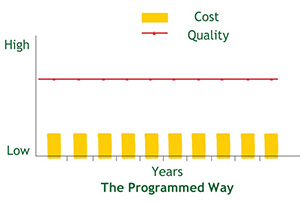Date published: September 14, 2015
 Keeping a consistent quality building maintenance plan is essential to successful corporate/owners corporation management. Painting gutters and essential structural elements are all responsibilities of the Occupier/Owner to keep maintained and up to standard.
Keeping a consistent quality building maintenance plan is essential to successful corporate/owners corporation management. Painting gutters and essential structural elements are all responsibilities of the Occupier/Owner to keep maintained and up to standard.
Keeping good maintenance helps a property retain or even increase its value, makes it a pleasant place to live for residents, and assists in preventing more serious damage and safety hazards.
Planning well head is essential to keep standards high and avoiding unwanted surprises.
Depending on the state as well as the size of the property, regulations will vary in regards to the required maintenance plans and maintenance cycles. Regardless of whether a plan is mandatory, it is recommended practice to implement a maintenance plan with a minimum forecast of 10 years, although 15 to 20 years is more common.
To finance this plan a long-term sinking fund will be required to ensure the cash flow is available to cover regular services.
A long-term forecast helps to identify repair and maintenance expenses that are likely to occur during the forecast period and calculate the amount of money the sinking fund will require to fund these expenses.
Long-term forecasting allows for preventative maintenance (regularly scheduled maintenance regardless of condition) of the property instead of reactive maintenance (only performed when conditions have deteriorated to an unacceptable level).
Just as a visit to the dentist every 6 months (while still uncomfortable) is much better than the pain and cost of not going and then needed a root canal, preventative maintenance of property provides stress and financial benefits over reactive maintenance.
Preventative maintenance keeps things in optimum condition, which helps the building looking consistently good increasing value, keeping residents happy and ensuring maximum life expectancy of a feature is achieved.
As reactive maintenance isn’t performed until it is no longer avoidable, it can bring about unexpected costs and downtime. Sourcing labour and materials on short notice will generally be far more expensive than when it has been scheduled in advance, and if something has been left to deteriorate long enough it could need to be completely replaced, incurring even further costs. Allowing a building and its facilities to deteriorate over an extended period of time can reduce the value of the property and leave residents feeling dissatisfied with their surroundings.


for Maintenance Managers keeping a regular painting programme is one of the most beneficial plans that can be undertaken. Consistent planned painting helps to protect external substrates like timber fascias and windows from breakdown, helping to extend the life of the building. Keeping the property’s appearance up to standard will help to maintain the property value and entice future residents.
Whittle Programmed Maintenance provide maintenance painting programmes tailored specifically to suit the unique needs of any property. With over 40 years’ experience in developing and delivering maintenance painting solutions across the UK. Whittle Programmed Maintenance can help ensure a property is kept to the highest quality, with consistent service and costing to simplify maintenance, improve appearance and save money.